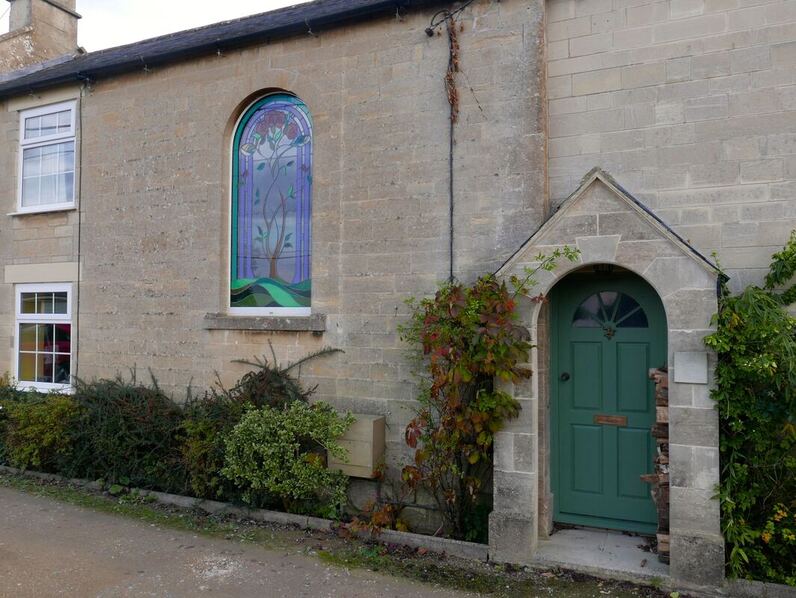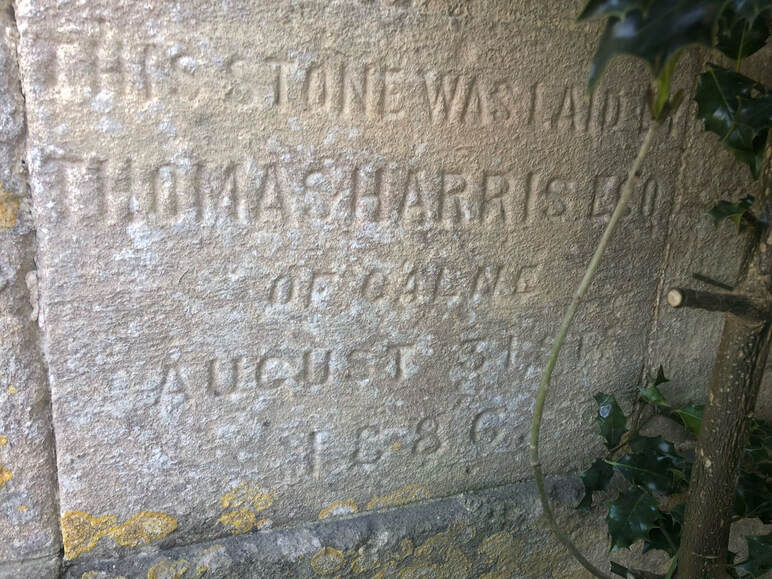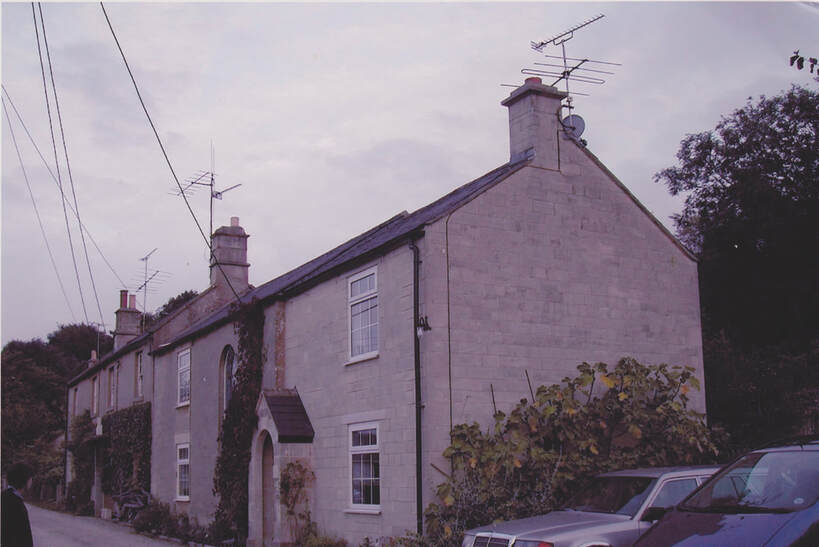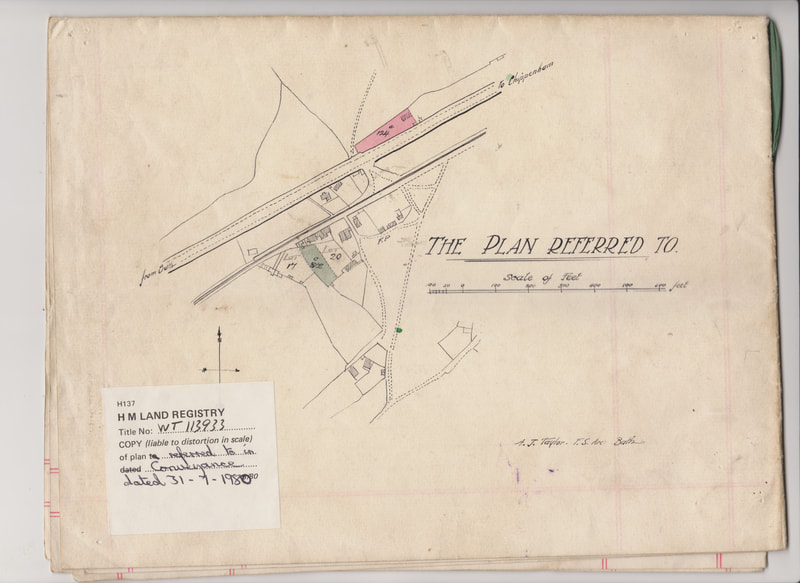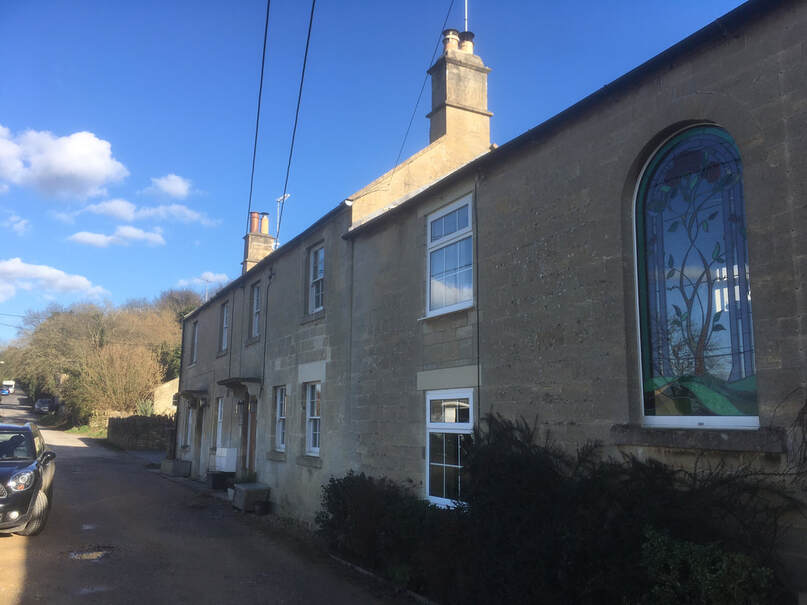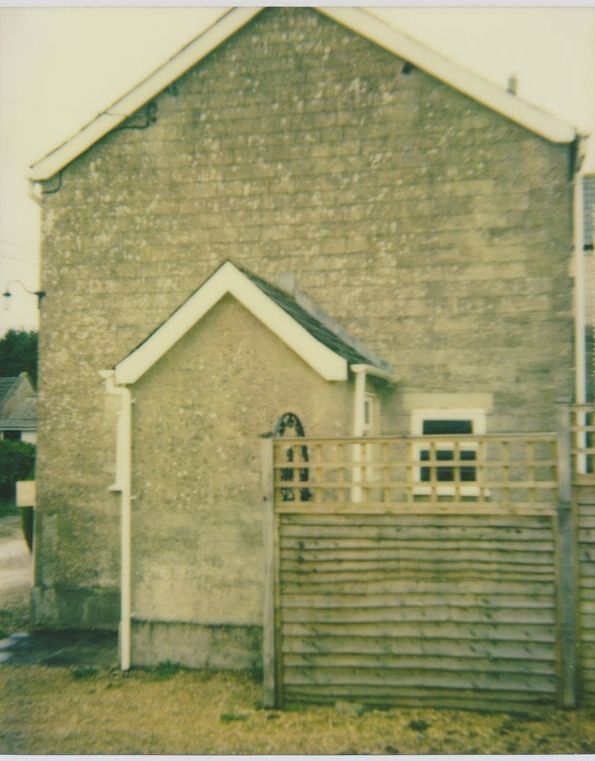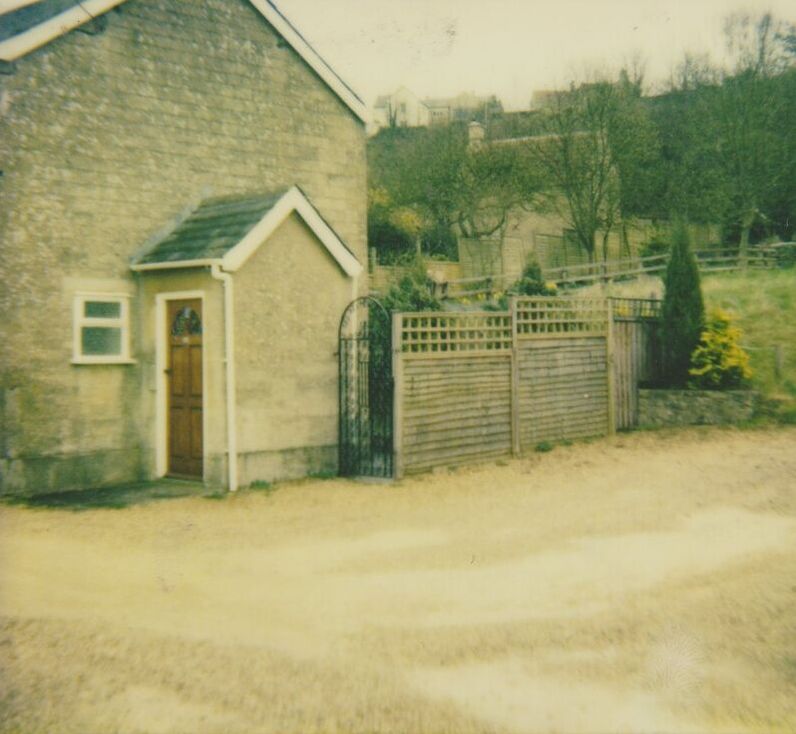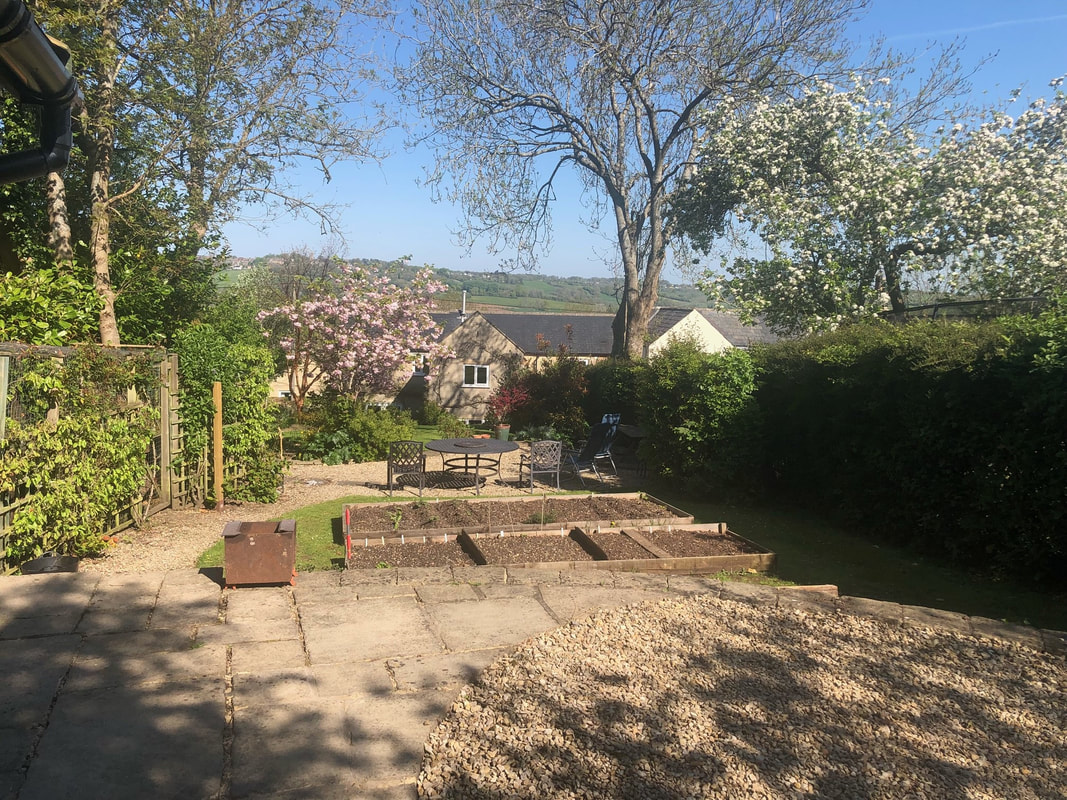Primitive Methodist Chapel Original Research Bernard & Ann Ainsworth July 2022
Why would you build a small church less than twenty years after a large church was built only 300 yards away? The answer is often that they served different purposes. That was certainly true of the Primitive Methodist Chapel built on Beech Road in 1886 after the United Methodist Chapel on the top of Box Hill in 1868.[1]
In January 1851 the trustees of the Blue Vein and Brickers’ Barn Turnpike Trust sold a portion of land adjoining the turnpike roadway to John Waite for the sum of £2.[2] The plot comprised 8 perches and a small triangular plot of land and was next to a cottage and garden occupied by him and his family as their home. John presumably converted the cottage into two, because later tenants were Jacob Dancey and Thomas Newman, the properties now called 1 and 2 Upway. John held the property for several years before in December 1863 he mortgaged it to Edwin Humphries, a Chippenham wheelwright, for £40. Seeking to provide for his family, in July 1866 John Waite borrowed an additional £100 from the Promoter Life Assurance & Annuity Company and created a 99-year tenancy for his wife Ann and two infant sons, John James and Wallace. He appointed Samuel Rowe Noble, quarryman/stone merchant, and George Tanner Elliott, carpenter/wheelwright/builder, as trustees of his finances and apparently guarantors and executors of his will. Noble and Elliott were liable for the repair of the properties, payment of insurance and mortgage interest and inherited the properties subject to certain payments to the children.
At this time, the Bristol District circuit of the Methodist Commission was planning to build a new United Methodist Chapel on top of Box Hill the hill near the Quarryman’s Arms. The Commissioners wanted to provide outreach missions to local communities and considered the Box Hill area had potential, lacking an Anglican Church and an area where many quarrymen wanted more in their lives than work and the pub. The Commission first visited the area in 1862 and decided that for a long time past a need has been felt for a chapel as locals had worshipped in a cottage for many years.[3] The top Box Hill chapel was built in 1868.
Building the Primitive Methodist Chapel, 1886
The concept for a second Box Hill chapel came about in the mid-1880s as a result of another similar outreach initiative. John Waite died on 30 June 1872 and the children (now living in Bermondsey, London) had come of age by 1879. In March 1881 Samuel Rowe Noble and George Tanner Elliott paid off the outstanding mortgages but the situation of the estate became more complicated when George Tanner Elliott died on 17 October 1881.
In 1885 Samuel Rowe Noble agreed to sell the freeholds of the properties for £160 to a group of Methodist trustees plus the superintendent of the Chippenham Circuit, Rev Edward Powell.[4] Presumably this sum was to cover the outstanding mortgages and the children’s inheritance. The properties comprised the two Upway cottages and a triangular piece of land amounting to 8 perches. This may have been the idea of Samuel Noble, who was a committed Methodist, but it is possible that the intention of John Waite and Edwin Humphries was that some of the land should be used to build a chapel for the use of People called Primitive Methodists as the Indenture referred to an 1864 intention to build a Methodist chapel in Walworth, Surrey. Either way, by May 1886, the Methodist Commission reported that a piece of ground had been procured for the erection a new chapel at Box Hill.[5] The commissioners themselves took out a mortgage of £100 to fund the arrangement.
At this time, the Bristol District circuit of the Methodist Commission was planning to build a new United Methodist Chapel on top of Box Hill the hill near the Quarryman’s Arms. The Commissioners wanted to provide outreach missions to local communities and considered the Box Hill area had potential, lacking an Anglican Church and an area where many quarrymen wanted more in their lives than work and the pub. The Commission first visited the area in 1862 and decided that for a long time past a need has been felt for a chapel as locals had worshipped in a cottage for many years.[3] The top Box Hill chapel was built in 1868.
Building the Primitive Methodist Chapel, 1886
The concept for a second Box Hill chapel came about in the mid-1880s as a result of another similar outreach initiative. John Waite died on 30 June 1872 and the children (now living in Bermondsey, London) had come of age by 1879. In March 1881 Samuel Rowe Noble and George Tanner Elliott paid off the outstanding mortgages but the situation of the estate became more complicated when George Tanner Elliott died on 17 October 1881.
In 1885 Samuel Rowe Noble agreed to sell the freeholds of the properties for £160 to a group of Methodist trustees plus the superintendent of the Chippenham Circuit, Rev Edward Powell.[4] Presumably this sum was to cover the outstanding mortgages and the children’s inheritance. The properties comprised the two Upway cottages and a triangular piece of land amounting to 8 perches. This may have been the idea of Samuel Noble, who was a committed Methodist, but it is possible that the intention of John Waite and Edwin Humphries was that some of the land should be used to build a chapel for the use of People called Primitive Methodists as the Indenture referred to an 1864 intention to build a Methodist chapel in Walworth, Surrey. Either way, by May 1886, the Methodist Commission reported that a piece of ground had been procured for the erection a new chapel at Box Hill.[5] The commissioners themselves took out a mortgage of £100 to fund the arrangement.
The dedication of the site as a chapel raced ahead and in September 1886 the foundation stone was laid by local Member of Parliament Mr GP Fuller (who attended notwithstanding that parliament has assembled) in the presence of various regional ministers.[6] It was a rather strange choice for the stone dedication, by a Liberal Member of Parliament and member of the Church of England. It seems to have been a rather rushed event as the stone dedication was engraved to Thomas Harris, Calne alderman and director of the famous bacon-curing company.
Nonetheless, the gathering celebrated the foundation with the hymn All hail the power of Jesu’s name. Mr Fuller made the point that no Church of England services were conducted on Box Hill, which accounted for the need. This neatly side-stepped the issue of the nearby Methodist Church on the top of Box Hill. Chippenham builder John Smith, tendered a quote of £170 for the construction of the actual building 28 feet long, 17 feet wide and 20 feet high. The chapel was finally opened in May 1887 and celebrated its anniversary in May 1888 with a sermon from Mr J Humphries of Bath and a public tea for the congregation and other locals.[7]
Funding the Chapel
The Society of the Primitive Methodists sought to return to the ideas of their movement’s founder John Wesley. The initiative started with Hugh Bourne from Stoke-on-Trent in 1810 and spread largely without doctrinal differences to other Methodist branches but with some practical differences, including the practice that the Primitive movement accepted lay, female preachers and open-air meetings. An example of the unity of the Methodist movement was that the foundation meeting of the Beech Road chapel later made its way to the top Box Hill schoolroom where Miss Pictor presided at the harmonium.
The new chapel reflected an openness to preach to poorly educated, stone-quarry workers on Box Hill who felt uncomfortable with the middle-class values which had permeated the United Methodist Chapel on the top of the Hill. As a voluntary church (funded by donations), the Primitive Chapel made an open and direct appeal to the very poorest, working-class people to support and fund the project. The foundation of the chapel on Beech Road was partly a statement against the money which had founded the United Methodist Church on Box Hill and the Ebenezer Chapel in the Market Place.
The trend of merging Anglican beliefs in the late 1800s influenced the attitude of both Methodist and Established Churches. A fundraising concert at the Church of England Box Schools in 1899 was in support of the Primitive Chapel.[8] The chapel continued to celebrate its foundation anniversaries into the early 1900s and, true to its core beliefs, held the 1904 celebration with an open-air service.[9] But money was problematic with the small congregation and multiple needs of the building, such as the organ repairs in 1902.[10] When larger premises were needed to accommodate numbers of up to 130 people, the organisers used the Adult School at Clift Quarry Works.[11]
Nonetheless, the gathering celebrated the foundation with the hymn All hail the power of Jesu’s name. Mr Fuller made the point that no Church of England services were conducted on Box Hill, which accounted for the need. This neatly side-stepped the issue of the nearby Methodist Church on the top of Box Hill. Chippenham builder John Smith, tendered a quote of £170 for the construction of the actual building 28 feet long, 17 feet wide and 20 feet high. The chapel was finally opened in May 1887 and celebrated its anniversary in May 1888 with a sermon from Mr J Humphries of Bath and a public tea for the congregation and other locals.[7]
Funding the Chapel
The Society of the Primitive Methodists sought to return to the ideas of their movement’s founder John Wesley. The initiative started with Hugh Bourne from Stoke-on-Trent in 1810 and spread largely without doctrinal differences to other Methodist branches but with some practical differences, including the practice that the Primitive movement accepted lay, female preachers and open-air meetings. An example of the unity of the Methodist movement was that the foundation meeting of the Beech Road chapel later made its way to the top Box Hill schoolroom where Miss Pictor presided at the harmonium.
The new chapel reflected an openness to preach to poorly educated, stone-quarry workers on Box Hill who felt uncomfortable with the middle-class values which had permeated the United Methodist Chapel on the top of the Hill. As a voluntary church (funded by donations), the Primitive Chapel made an open and direct appeal to the very poorest, working-class people to support and fund the project. The foundation of the chapel on Beech Road was partly a statement against the money which had founded the United Methodist Church on Box Hill and the Ebenezer Chapel in the Market Place.
The trend of merging Anglican beliefs in the late 1800s influenced the attitude of both Methodist and Established Churches. A fundraising concert at the Church of England Box Schools in 1899 was in support of the Primitive Chapel.[8] The chapel continued to celebrate its foundation anniversaries into the early 1900s and, true to its core beliefs, held the 1904 celebration with an open-air service.[9] But money was problematic with the small congregation and multiple needs of the building, such as the organ repairs in 1902.[10] When larger premises were needed to accommodate numbers of up to 130 people, the organisers used the Adult School at Clift Quarry Works.[11]
Running the Chapel
After the Great War, the chapel thrived under the control of administrators, Robert John Dyer, H Brewer and HB Little, and dedicated members, such as the families of Charles Hancock, Walter Sheppard, William Moules and Arthur Tinson.[12] But it wasn’t easy because its congregation mostly came from a few stone quarrying families, many of whom were abroad for many years during the war. In 1917 the Bristol District Circuit was actively engaged on fundraising to reduce the debt (of the Primitive Chapel) at Box Hill.[13] In the inter-war years, the Chapel appears to have been struggling again, largely as a result of the decline of the stone-quarrying industry. The Adult School was used for promotional concerts in February 1928 which, rather strangely for the month, ended with a rendition of Auld Lang Syne.[14] In February 1930 the church trustees were obliged to sell the two Upway cottages to Thomas Granger of Corsham in order to repay debts incurred.[15]
The union of various branches of the Methodist movement led to a merger of all the chapels in Box in 1932.[16] In 1932 harvest thanksgiving services referred to Messrs Stebbins and Scholefield as preachers, Mrs Brooke at the organ with soloists Misses Hemmings and Fry.[17] After the merger, Rev JK Scholefield became responsible for all the Methodist Churches in the Box area although he retired due to ill-health in 1933.[18]
After the Great War, the chapel thrived under the control of administrators, Robert John Dyer, H Brewer and HB Little, and dedicated members, such as the families of Charles Hancock, Walter Sheppard, William Moules and Arthur Tinson.[12] But it wasn’t easy because its congregation mostly came from a few stone quarrying families, many of whom were abroad for many years during the war. In 1917 the Bristol District Circuit was actively engaged on fundraising to reduce the debt (of the Primitive Chapel) at Box Hill.[13] In the inter-war years, the Chapel appears to have been struggling again, largely as a result of the decline of the stone-quarrying industry. The Adult School was used for promotional concerts in February 1928 which, rather strangely for the month, ended with a rendition of Auld Lang Syne.[14] In February 1930 the church trustees were obliged to sell the two Upway cottages to Thomas Granger of Corsham in order to repay debts incurred.[15]
The union of various branches of the Methodist movement led to a merger of all the chapels in Box in 1932.[16] In 1932 harvest thanksgiving services referred to Messrs Stebbins and Scholefield as preachers, Mrs Brooke at the organ with soloists Misses Hemmings and Fry.[17] After the merger, Rev JK Scholefield became responsible for all the Methodist Churches in the Box area although he retired due to ill-health in 1933.[18]
The merger breathed new life into the Beech Road Chapel and more building work took place. In September 1934 Walter Sheppard (owner of the Box Hill Post Office) left more land to the chapel to enable the chapel trustees to build a wooden hut and to re-erect the washhouse.[19] He had bought two plots of land either side of the new turnpike road from the family of Sir Edward Northey for £151 in 1923 and agreed to donate a garden plot to the chapel (Lot 20, now the rear garden of the chapel). The trustees went further and built a hut, washhouse (for quarrymen to clean up before going into the chapel) and schoolroom, made of wood on stone foundations.[20] The washhouse has unfortunately now been demolished. The opening ceremony of the new building was led by Charles WB Oatley and the Rev J Herbert Slater of Chippenham. Musical entertainment and songs were provided by Mrs Pinker, Miss Pinnock, W Greenman and M Barnett. Even though the work was done by young people from Box Hill, the cost of materials had to be paid for and a debt existed of £25. At a New Year’s Eve social event that year, it was reported that over 100 people attended to help finance the debt.[21]
Later Church History
The Primitive Church had largely appealed to older residents on Box Hill and, as time passed, many had died. One of the oldest residents was Rebecca Hancock (1844-1935), a supporter of Primitive Methodism for all of her 91 years. In 1881 she and her husband Charles opened their home at Millsplatt Cottages for weekly worship.[22] When they moved to Ivy Cottage, Box Hill, Charles gave up his job as a stone mason and became a baker. They were leading supporters of the Beech Road Chapel, where Charles served as a lay preacher, Sunday School Superintendent, unpaid cleaner and active proponent of the 1934 extension. Charles and Rebecca kept a garden fruit tree specifically to sell produce for church mission funds.
The building continued to be used as a Methodist chapel and the description of services seems similar to the United Church with circuit minister Rev Hugh H Bradley preaching, young G Maynard at organ, Miss E Barnett and Miss Sheppard performing a duet in 1938. The service for the death of Sarah Jane Sheppard (from the Box Hill Post Office on the A4) was held at the Primitive Chapel in March 1938, a deeply moving service as she had run the family life of her husband, son and grandchildren after the early death of her daughter-in-law. By this time, the chapel was recorded as ex-Primitive Methodist Chapel.[23] In later years Renee Bishop played the harmonium in the chapel (she would also tell how she attended Box School as a child wearing wooden clogs).
The former Primitive Methodist Church belonged to the Chippenham Circuit, unlike the other Methodist churches in Box, which belonged to the Bath United Methodist circuit. Beech Road chapel closed in 1957, with the remaining members, Mr and Mrs Maynard, joining the congregation at the upper Box Hill United Methodist Church.[24]
Later Church History
The Primitive Church had largely appealed to older residents on Box Hill and, as time passed, many had died. One of the oldest residents was Rebecca Hancock (1844-1935), a supporter of Primitive Methodism for all of her 91 years. In 1881 she and her husband Charles opened their home at Millsplatt Cottages for weekly worship.[22] When they moved to Ivy Cottage, Box Hill, Charles gave up his job as a stone mason and became a baker. They were leading supporters of the Beech Road Chapel, where Charles served as a lay preacher, Sunday School Superintendent, unpaid cleaner and active proponent of the 1934 extension. Charles and Rebecca kept a garden fruit tree specifically to sell produce for church mission funds.
The building continued to be used as a Methodist chapel and the description of services seems similar to the United Church with circuit minister Rev Hugh H Bradley preaching, young G Maynard at organ, Miss E Barnett and Miss Sheppard performing a duet in 1938. The service for the death of Sarah Jane Sheppard (from the Box Hill Post Office on the A4) was held at the Primitive Chapel in March 1938, a deeply moving service as she had run the family life of her husband, son and grandchildren after the early death of her daughter-in-law. By this time, the chapel was recorded as ex-Primitive Methodist Chapel.[23] In later years Renee Bishop played the harmonium in the chapel (she would also tell how she attended Box School as a child wearing wooden clogs).
The former Primitive Methodist Church belonged to the Chippenham Circuit, unlike the other Methodist churches in Box, which belonged to the Bath United Methodist circuit. Beech Road chapel closed in 1957, with the remaining members, Mr and Mrs Maynard, joining the congregation at the upper Box Hill United Methodist Church.[24]
Upway Cottages
Upway Cottages are very old, facing the old turnpike road. In 1911 the occupant of number 2 was named in the census records as Herbert Mumford (17 February 1874-), a stone sawyer, and his wife of one year Elizabeth Emily (nee Wootten) born in 1883 but there is no record of who lived in number 1.
In the 1923 Northey auction they were tenanted by Herbert Mumford and Thomas Henry Tinson: 20 Herbert Mumford, plot garden land behind Upway Cottages
21 Thomas Henry Tinson, plot garden land behind the Primitive Chapel
17 Thomas Henry Tinson, semi-detached cottage and garden
16 Herbert Mumford, semi-detached cottage (one bedroom plus one other room) and garden
In 1939 the tenants of the cottages were listed as:
Number 1: James Hancock (24 December 1872-) with his wife Ada (28 August 1870-).
Number 2: Herbert Mumford (17 February 1874-), a stone sawyer, his wife Elizabeth Emily Wootten (28 May 1883-), who were married in 1910 and a lodger Ernest Rice.
In 1956 Frederick Loxton lived in number 1 Upway and until 1970 Mr Byfield owned it, whilst his family ran the grocers on the corner of Chapel Lane until it was demolished. In 2006 Elaine Savage put on a sculpture exhibition there, including one from the Royal Academy of Arts.[25]
Plans for Changing Use
Control of the chapel fell to the trustees, most of them from Chippenham and including only one village person, Frank Maynard, grocer (from the Stores, Box Hill). On 28 March 1957 the chapel was sold to Tom Selwyn-Smith (Box Anglican vicar), Bill Chaffey (chairman of Parish Council) and Stan Harper (Box Council clerk) for a nominal £100 for possible use as a Boys’ Club.
Upway Cottages are very old, facing the old turnpike road. In 1911 the occupant of number 2 was named in the census records as Herbert Mumford (17 February 1874-), a stone sawyer, and his wife of one year Elizabeth Emily (nee Wootten) born in 1883 but there is no record of who lived in number 1.
In the 1923 Northey auction they were tenanted by Herbert Mumford and Thomas Henry Tinson: 20 Herbert Mumford, plot garden land behind Upway Cottages
21 Thomas Henry Tinson, plot garden land behind the Primitive Chapel
17 Thomas Henry Tinson, semi-detached cottage and garden
16 Herbert Mumford, semi-detached cottage (one bedroom plus one other room) and garden
In 1939 the tenants of the cottages were listed as:
Number 1: James Hancock (24 December 1872-) with his wife Ada (28 August 1870-).
Number 2: Herbert Mumford (17 February 1874-), a stone sawyer, his wife Elizabeth Emily Wootten (28 May 1883-), who were married in 1910 and a lodger Ernest Rice.
In 1956 Frederick Loxton lived in number 1 Upway and until 1970 Mr Byfield owned it, whilst his family ran the grocers on the corner of Chapel Lane until it was demolished. In 2006 Elaine Savage put on a sculpture exhibition there, including one from the Royal Academy of Arts.[25]
Plans for Changing Use
Control of the chapel fell to the trustees, most of them from Chippenham and including only one village person, Frank Maynard, grocer (from the Stores, Box Hill). On 28 March 1957 the chapel was sold to Tom Selwyn-Smith (Box Anglican vicar), Bill Chaffey (chairman of Parish Council) and Stan Harper (Box Council clerk) for a nominal £100 for possible use as a Boys’ Club.
The chapel and back garden site in 1992 (courtesy Bernard Ainsworth)
It didn’t work out (allegedly because the members didn’t want to walk so far up the hill) and the chapel was then purchased by Harold May of 21 Hazelbury Hill, Box, for £175 in January 1962 who held it for a few months before selling to Desmond and Raymond Paradise, Bath Builders in November 1962 for £350. The garden was sold by Walter Sheppard’s family at Ivy Cottage to Alec Thomas Dancey, boilerman, of Jasmine Cottage in 1954 until it was also bought by Harold May in 1962 and then sold to the Paradise brothers, who also renovated Boxhill Cottages.
In October 1974 the property was bought for £3,800 as a workshop and stores by Jack Hazell then living at The Manor House, Box, who moved to Amberwell, Box Hill. Jack ran Ashley Industrial Distributors Ltd, a sign engraving business, and used the premises at the bottom of his Amberwell garden as a concrete chemical store and a depository, reinforcing the floors and putting a tarmac drive at the side of the property. Jean Diffell cleaned the house for the Hazells. In June 1992 the property was sold by Jack and his wife Christina to Bernard and Anne Ainsworth, who moved there from 2 Boxhill Cottages and have since been occupied in renovating it into a private residence.
In October 1974 the property was bought for £3,800 as a workshop and stores by Jack Hazell then living at The Manor House, Box, who moved to Amberwell, Box Hill. Jack ran Ashley Industrial Distributors Ltd, a sign engraving business, and used the premises at the bottom of his Amberwell garden as a concrete chemical store and a depository, reinforcing the floors and putting a tarmac drive at the side of the property. Jean Diffell cleaned the house for the Hazells. In June 1992 the property was sold by Jack and his wife Christina to Bernard and Anne Ainsworth, who moved there from 2 Boxhill Cottages and have since been occupied in renovating it into a private residence.
Conclusion
The rise of the Methodism brought new life and initiatives to the Box Hill area. Some of the most intriguing activists were the self-help groups such as those who founded the Primitive Chapel on Beech Road. It wasn’t planned but evolved by chance and the dedication of the members. The Beech Road chapel is a testament to the help that the church brought to some of those in greatest need.
The rise of the Methodism brought new life and initiatives to the Box Hill area. Some of the most intriguing activists were the self-help groups such as those who founded the Primitive Chapel on Beech Road. It wasn’t planned but evolved by chance and the dedication of the members. The Beech Road chapel is a testament to the help that the church brought to some of those in greatest need.
References
[1] The Wiltshire Times, 6 October 1934
[2] Abstract of Title, 1884
[3] The Wiltshire Times, 4 September 1886
[4] The original trustees comprised Charles Robert Stevens (boot manufacturer), Ebenezer Marsh (furniture dealer), George Elms (gardener), Charles Butler (tea dealer), Jacob North (baker), Charles Hancock (mason), Thomas Bull (road foreman), John Edwin Neate (quarryman), George Maynard (bootmaker), Frederick Woodward (baker), George Little (labourer) and Lewis Rumming (foreman) (per Epitome of Title 28 March 1957)
[5] The Wiltshire Times, 1 May 1886
[6] The Wiltshire Times, 4 September 1886
[7] The Wiltshire Times, 26 May 1888
[8] Wiltshire Times and Trowbridge Advertiser, 4 March 1899
[9] Wiltshire Times and Trowbridge Advertiser, 23 July 1904
[10] Wiltshire Times and Trowbridge Advertiser, 24 May 1902
[11] Wiltshire Times and Trowbridge Advertiser, 26 October 1907
[12] Wiltshire Times and Trowbridge Advertiser, 9 June 1917 and 18 May 1918
[13] Wiltshire Times and Trowbridge Advertiser, 1 December 1917
[14] The Wiltshire Times, 11 February 1928
[15] Abstract of Title, 1957
[16] Wiltshire Times and Trowbridge Advertiser, 10 September 1932
[17] Wiltshire Times and Trowbridge Advertiser, 24 September 1932
[18] Wiltshire Times and Trowbridge Advertiser, 17 June 1933
[19] Abstract of title, 1957
[20] The Wiltshire Times, 6 October 1934
[21] The Wiltshire Times, 5 January 1935
[22] The Wiltshire Times, 16 February 1935
[23] Bath Chronicle and Herald, 5 March 1938
[24] Courtesy Michael Rumsey
[25] Parish Magazine, June 2006
[1] The Wiltshire Times, 6 October 1934
[2] Abstract of Title, 1884
[3] The Wiltshire Times, 4 September 1886
[4] The original trustees comprised Charles Robert Stevens (boot manufacturer), Ebenezer Marsh (furniture dealer), George Elms (gardener), Charles Butler (tea dealer), Jacob North (baker), Charles Hancock (mason), Thomas Bull (road foreman), John Edwin Neate (quarryman), George Maynard (bootmaker), Frederick Woodward (baker), George Little (labourer) and Lewis Rumming (foreman) (per Epitome of Title 28 March 1957)
[5] The Wiltshire Times, 1 May 1886
[6] The Wiltshire Times, 4 September 1886
[7] The Wiltshire Times, 26 May 1888
[8] Wiltshire Times and Trowbridge Advertiser, 4 March 1899
[9] Wiltshire Times and Trowbridge Advertiser, 23 July 1904
[10] Wiltshire Times and Trowbridge Advertiser, 24 May 1902
[11] Wiltshire Times and Trowbridge Advertiser, 26 October 1907
[12] Wiltshire Times and Trowbridge Advertiser, 9 June 1917 and 18 May 1918
[13] Wiltshire Times and Trowbridge Advertiser, 1 December 1917
[14] The Wiltshire Times, 11 February 1928
[15] Abstract of Title, 1957
[16] Wiltshire Times and Trowbridge Advertiser, 10 September 1932
[17] Wiltshire Times and Trowbridge Advertiser, 24 September 1932
[18] Wiltshire Times and Trowbridge Advertiser, 17 June 1933
[19] Abstract of title, 1957
[20] The Wiltshire Times, 6 October 1934
[21] The Wiltshire Times, 5 January 1935
[22] The Wiltshire Times, 16 February 1935
[23] Bath Chronicle and Herald, 5 March 1938
[24] Courtesy Michael Rumsey
[25] Parish Magazine, June 2006
